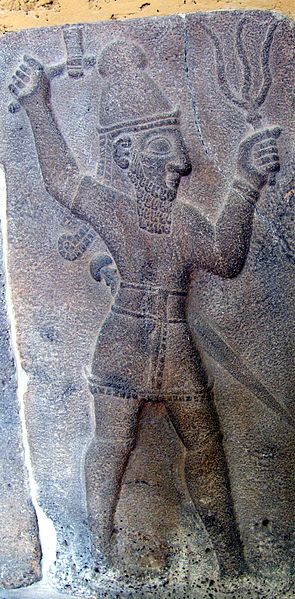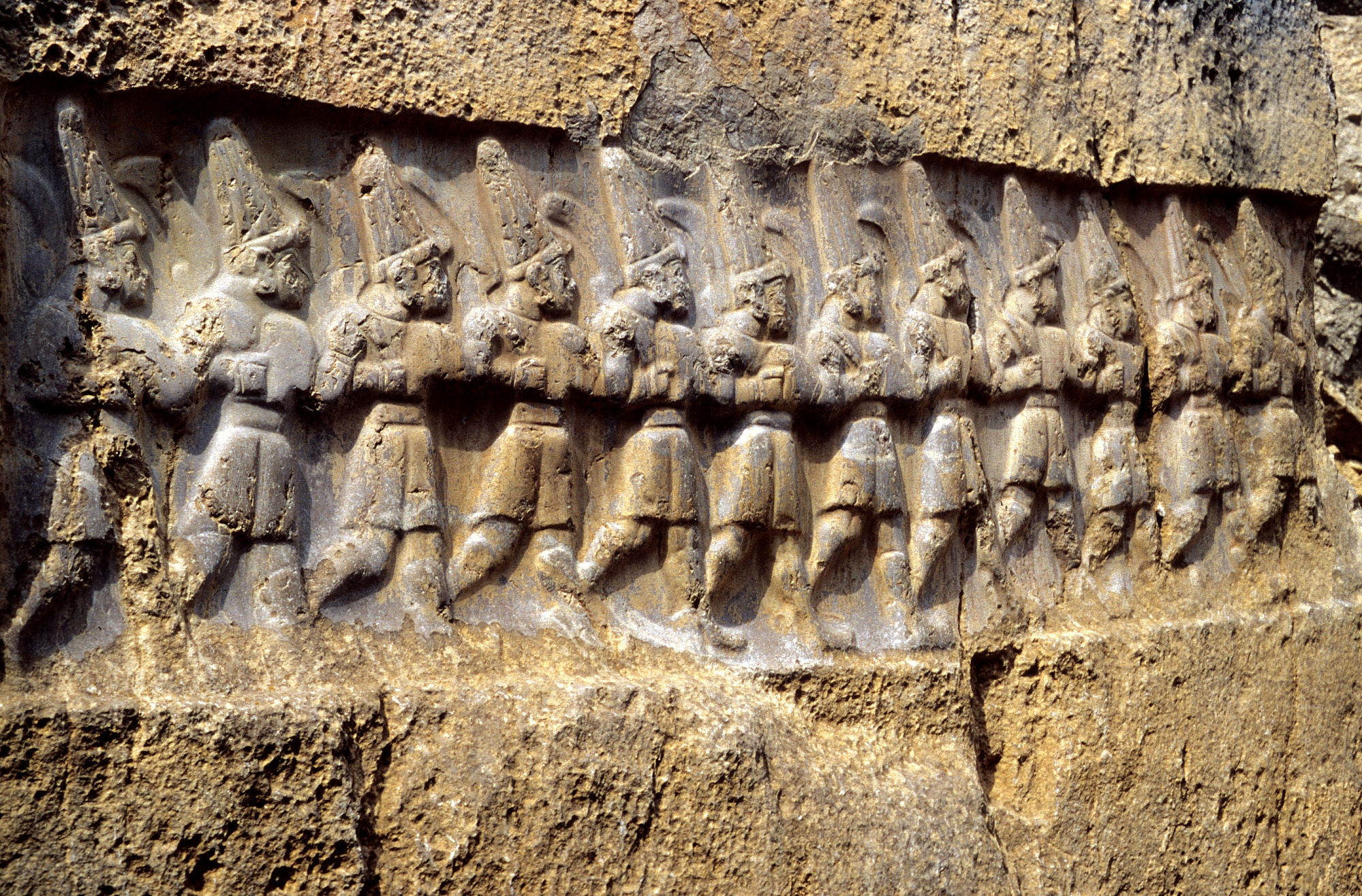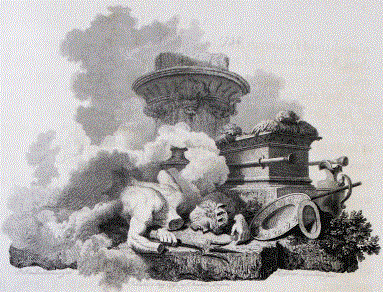|
Kumarbi
Kumarbi, also known as Kumurwe, Kumarwi and Kumarma, was a Hurrian god. He held a senior position in the Hurrian pantheon, and was described as the "father of gods". He was portrayed as an old, deposed king of the gods, though this most likely did not reflect factual loss of the position of the head of the pantheon in Hurrian religion, but only a mythological narrative. It is often assumed that he was an agricultural deity, though this view is not universally accepted and the evidence is limited. He was also associated with prosperity. It was believed that he resided in the underworld. Multiple Hurrian deities were regarded as Kumarbi's children, including Teshub, whom he conceived after biting off the genitals of Anu. They were regarded as enemies. In myths dealing with the conflict between them Kumarbi fathers various enemies meant to supplant the weather god, such as the stone giant Ullikummi. Kumarbi was also closely associated with other deities who were regarded as the ... [...More Info...] [...Related Items...] OR: [Wikipedia] [Google] [Baidu] |
Teshub
Teshub was the Hurrians, Hurrian weather god, as well as the head of the Hurrian pantheon. The etymology of his name is uncertain, though it is agreed it can be classified as linguistically Hurrian language, Hurrian. Both Phonetics, phonetic and Logogram, logographic writings are attested. As a deity associated with the weather, Teshub could be portrayed both as destructive and protective. Individual weather phenomena, including winds, lightning, thunder and rain, could be described as his weapons. He was also believed to enable the growth of vegetation and create rivers and springs. His high position in Hurrian religion reflected the widespread importance of weather gods in northern Mesopotamia and nearby areas, where in contrast with the south agriculture relied primarily on rainfall rather than irrigation. It was believed that his authority extended to both mortal and other gods, both on earth and in heaven. However, the sea and the underworld were not under his control. Depictio ... [...More Info...] [...Related Items...] OR: [Wikipedia] [Google] [Baidu] |
Hurrian Religion
The Hurrian religion was the polytheistic religion of the Hurrians, a Bronze Age people of the Near East who chiefly inhabited the north of the Fertile Crescent. While the oldest evidence goes back to the third millennium Common Era, BCE, it is best attested in cuneiform sources from the second millennium BCE written not only in the Hurrian language, but also Akkadian language, Akkadian, Hittite language, Hittite and Ugaritic. It was shaped by contacts between the Hurrians and the various cultures with which they coexisted. As a result, the Hurrian pantheon included both natively Hurrian deities and those of foreign origin, adopted from List of Mesopotamian deities, Mesopotamian, Syrian (chiefly Eblaite and Ugaritic religion, Ugaritic), Anatolian and Elamite beliefs. The culture of the Hurrians was not entirely homogeneous, and different local religious traditions are documented in sources from Hurrian kingdoms such as Arrapha, Kizzuwatna and Mitanni, as well as from cities with s ... [...More Info...] [...Related Items...] OR: [Wikipedia] [Google] [Baidu] |
Hurrian God
The Hurrian pantheon consisted of gods of varied backgrounds, some of them natively Hurrian, while others adopted from other pantheons, for example Eblaite and Mesopotamian. Like the other inhabitants of the Ancient Near East, Hurrians regarded their gods as anthropomorphic. They were usually represented in the form of statues holding the symbols associated with a specific deity. The Yazılıkaya sanctuary, which was Hittite in origin but served as a center of the practice of Hurrian religion, is considered a valuable source of information about their iconography. Hurrians organized their gods into lists known as ''kaluti'' or into similar lexical lists as the Mesopotamians. The formal structure of the pantheon was most likely based on either Mesopotamian or Syrian theology. The status of individual deities and composition of the pantheon could vary between individual locations, but some can nonetheless be identified as "pan-Hurrian." The following list does not include deities ... [...More Info...] [...Related Items...] OR: [Wikipedia] [Google] [Baidu] |
Šauška
Šauška (Shaushka), also called Šauša or Šawuška, was the highest ranked goddess in the Hurrian pantheon. She was associated with love and war, as well as with incantations and by extension with healing. While she was usually referred to as a goddess and with feminine titles, such as ''allai'' (Hurrian language, Hurrian: "lady"), references to masculine Šauška are also known. The Hurrians associated her with Nineveh, but she was also worshiped in many other centers associated with this culture, from Anatolian cities in Kizzuwatna, through Alalakh and Ugarit in Syria (region), Syria, to Nuzi and Ulamme in northeastern Mesopotamia. She was also worshiped in southern Mesopotamia, where she was introduced alongside a number of other foreign deities in the Third Dynasty of Ur, Ur III period. In this area, she came to be associated with Ishtar. At a later point in time, growing Hurrian influence on Hittites, Hittite culture resulted in the adoption of Šauška into the Hittite sta ... [...More Info...] [...Related Items...] OR: [Wikipedia] [Google] [Baidu] |
Alalu
Alalu or Alala was a primordial figure in Mesopotamian and Hurrian mythology. He is also known from documents from Emar, where he was known as Alal. While his role was not identical in these three contexts, it is agreed that all three versions share the same origin. Hurrian Alalu, who plays the role of the oldest king of gods in the ''Kumarbi Cycle'', is the best known, and is commonly discussed in scholarship focused on comparative mythology but it is agreed Mesopotamian Alala represents the oldest tradition regarding this being. However, the precise etymology of his name is unknown, and likely neither Sumerian nor Semitic. Both Hurrian and Mesopotamian sources attest an association between him and Anu, but its nature varies between cultures. Mesopotamian sources The origin of the name Alala is not known, and in scholarship it is tentatively grouped with other Mesopotamian deity names with no clear Sumerian or Semitic etymologies, such as Zababa, Aruru or Bunene. Alala is ... [...More Info...] [...Related Items...] OR: [Wikipedia] [Google] [Baidu] |
Aranzaḫ
Aranzaḫ (alternatively romanized as Aranzah), also known as Aranziḫ or Araššiḫ was a Hurrian deity who represented the river Tigris. He was believed to be one of the deities born as a result of Kumarbi biting off the genitals of Anu during a battle over kingship in heaven. He also appears in a myth focused on a hero named after him, Gurparanzaḫ, in which he acts as his ally. He is also attested in numerous Hurrian theophoric names. A handful of attestations of his name have been identified in Ugaritic and Mesopotamian texts as well. Additionally, it has been suggested that the Assyrian references to offerings made to the source of the Tigris in Shubria in the first millennium BCE were linked to earlier Hurrian worship of the Tigris as a deity. Name and character It is presumed that Aranzaḫ, the name used by Hurrians to refer to the river Tigris, has Hurrian origin, but its precise etymology remains unknown. The river was perceived as a numen in Hurrian religion. Ara ... [...More Info...] [...Related Items...] OR: [Wikipedia] [Google] [Baidu] |
Dagan (god)
Dagon or Dagan (; ) was a god worshipped in ancient Syria, across the middle of the Euphrates, with primary temples located in Tuttul and Terqa, though many attestations of his cult come from cities such as Mari and Emar as well. In settlements situated in the upper Euphrates area, he was regarded as the "father of gods" similar to Mesopotamian Enlil or Hurrian Kumarbi, as well as a lord of the land, a god of prosperity, and a source of royal legitimacy. A large number of theophoric names, both masculine and feminine, attests that he was a popular deity. He was also worshiped further east, in Mesopotamia, where many rulers regarded him as the god capable of granting them kingship over the western areas. Attestations of Dagan from coastal areas are much less frequent and come mostly from the northern city of Ugarit, where Dagan's cult had a limited scope. According to the Hebrew Bible, Dagan was also the national god of the Philistines, with temples at Ashdod and Gaza, but the ... [...More Info...] [...Related Items...] OR: [Wikipedia] [Google] [Baidu] |
Tigris
The Tigris ( ; see #Etymology, below) is the eastern of the two great rivers that define Mesopotamia, the other being the Euphrates. The river flows south from the mountains of the Armenian Highlands through the Syrian Desert, Syrian and Arabian Deserts, before merging with the Euphrates and reaching to the Persian Gulf. The Tigris passes through historical cities like Mosul, Tikrit, Samarra, and Baghdad. It is also home to archaeological sites and ancient religious communities, including the Mandaeans, who use it for Masbuta, baptism. In ancient times, the Tigris nurtured the Assyria, Assyrian Empire, with remnants like the relief of Tiglath-Pileser I, King Tiglath-Pileser. Today, the Tigris faces modern threats from geopolitical instability, dam projects, poor water management, and climate change, leading to concerns about its sustainability. Efforts to protect and preserve the river's legacy are ongoing, with local archaeologists and activists working to safeguard its future ... [...More Info...] [...Related Items...] OR: [Wikipedia] [Google] [Baidu] |
Shalash
Shalash (Šalaš) was a Syrian goddess best known as the wife of Dagan, the head of the pantheon of the middle Euphrates area. She was already worshiped in Ebla and Tuttul in the third millennium BCE, and later her cult is attested in Mari as well. She was also introduced to the Mesopotamian and Hurrian pantheons. Both in ancient Mesopotamian texts and in modern scholarships a long-standing issue is the differentiation between Shalash and the similarly named Shala, wife of the weather god Ishkur/Adad in Mesopotamia. Name The etymology of the name Shalash is unknown. Based on the attestations in the Ebla texts, theories of Hurrian origin can be rejected. However, as noted by Alfonso Archi, there is no plausible Semitic etymology either, similar as in the case of other Syrian deities like Kubaba or Aštabi. Lluis Feliu proposes that it might have originated in an unknown substrate language. The spellings d''sa-a-ša'', d''sa-a-sa'' and d''ša-la-ša'' are attested in docum ... [...More Info...] [...Related Items...] OR: [Wikipedia] [Google] [Baidu] |
Tašmišu
Tašmišu (Tashmishu) was a Hurrian god. He was regarded as a brother of Teshub, and it is assumed he had a warlike character. Character Volkert Haas proposed that Tašmišu's name was derived from the Hurrian language, Hurrian word ''tašmi'', which he translates as strong. The suffix -''šu'' is also known from the name of one Teshub's bulls, Šerišu, and various Hurrian personal names, such as Anniwašu or Ekammešu. Tašmišu was one of the multiple warrior gods in the Hurrian pantheon. Other such deities were Ugur (god), Ugur, Aštabi, Nergal and Ḫešui. In myths, his position appears to be that of a subordinate of his brother Teshub, and in one passage from the ''Song of Ullikummi'' he outright addresses him as "my lord." He served as his sukkal (attendant deity), though as noted by Daniel Schwemer this role in ritual texts could also be attributed to the god Tenu. He proposed that the latter was adopted from the religious tradition of ancient Aleppo, where a month was ... [...More Info...] [...Related Items...] OR: [Wikipedia] [Google] [Baidu] |
Ullikummi
__NOTOC__ In Hurrian mythology, Ullikummi is a giant stone monster, son of Kumarbi and the sea god's daughter, Sertapsuruhi, or a female cliff. The language of the literary myth in its existing redaction is Hittite, in cuneiform texts recovered at Bogaskoy, where some Hurrian fragments of the ''Song of Ullikummi'' have been found. ''See'' Guterbock (1951). The ''Song of Ullikummi'' was recognized from its first rediscovery as a predecessor of Greek myths in Hesiod. Parallels to the Greek myth of Typhon, the ancient antagonist of the thunder-god Zeus, have been elucidated by Burkert. The ''Song'' possesses information on the Hittite creation myth, including the idea that there was a separation of heaven and earth in the primordial past, before which, the two were united. The story of Ullikummi The narrative of Ullikummi is one episode, the best preserved and most complete, in an epic cycle of related "songs" about the god Kumarbi, who aimed to replace the weather god Teshub and ... [...More Info...] [...Related Items...] OR: [Wikipedia] [Google] [Baidu] |
Mesopotamian God
Deities in ancient Mesopotamia were almost exclusively Anthropomorphism, anthropomorphic. They were thought to possess extraordinary powers and were often envisioned as being of tremendous physical size. The deities typically wore ''melam'', an ambiguous substance which "covered them in terrifying splendor" and which could also be worn by heroes, kings, giants, and even demons. The effect that seeing a deity's ''melam'' has on a human is described as ''ni'', a word for the "Paresthesia, physical creeping of the flesh". Both the Sumerian language, Sumerian and Akkadian languages contain many words to express the sensation of ''ni'', including the word ''puluhtu'', meaning "fear". Deities were almost always depicted wearing horned caps, consisting of up to seven superimposed pairs of ox-horns. They were also sometimes depicted wearing clothes with elaborate decorative gold and silver ornaments sewn into them. The ancient Mesopotamians believed that their deities lived in Heaven, ... [...More Info...] [...Related Items...] OR: [Wikipedia] [Google] [Baidu] |







